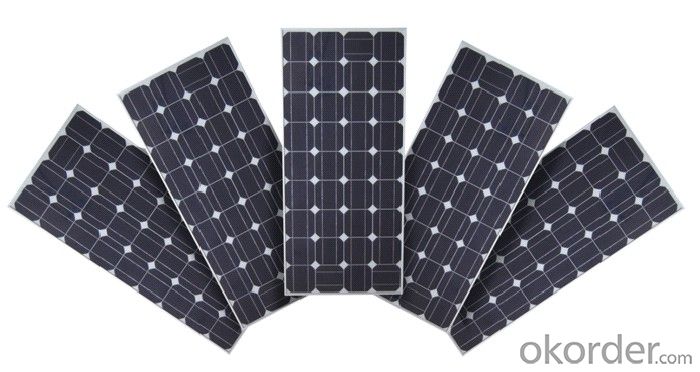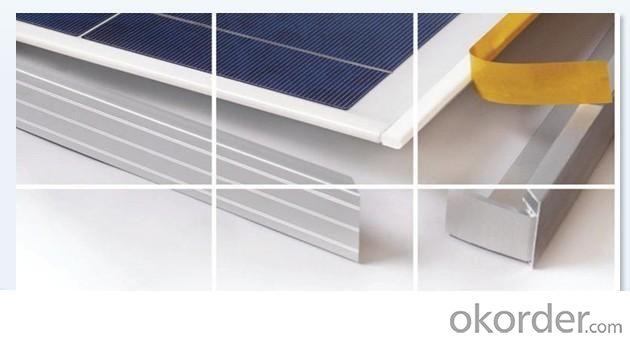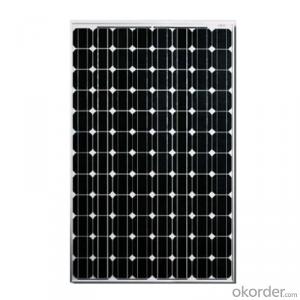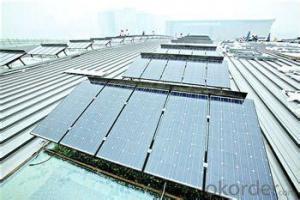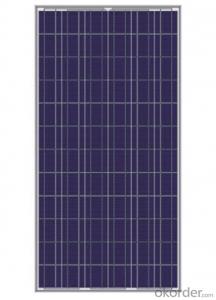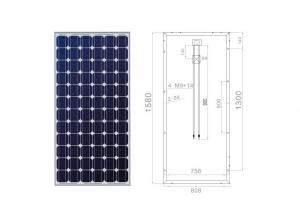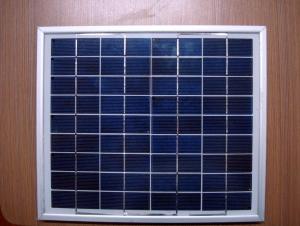Miami Construction Code Type Solar Panels - Solar System, Solar Module/Panel, PV Solar Panel Module
- Loading Port:
- China main port
- Payment Terms:
- TT OR LC
- Min Order Qty:
- 1 pc
- Supply Capability:
- 10000000 pc/month
OKorder Service Pledge
Quality Product, Order Online Tracking, Timely Delivery
OKorder Financial Service
Credit Rating, Credit Services, Credit Purchasing
You Might Also Like
Quick Details
| Place of Origin: | Guangdong China (Mainland) | Brand Name: | sunny energy | Model Number: | SEM-200W-P |
| Material: | Polycrystalline Silicon | Size: | 1482*992*50mm | Number of Cells: | 6*12pcs |
| Max. Power: | 215W | certificate: | IEC,CSA,MCS | weight: | 24.5kg |
| lifespan: | 25years | cell: | Motech | leadtime: | 15~25days |
| sample: | available |
Packaging & Delivery
| Packaging Detail: | 2pcs in one carton,and we could also package as your request.. |
| Delivery Detail: | 25days |
Specifications
solar module:
1)High quality & efficiency
2)CSA/IEC/CEC certificate
3)Pm is notless than 90% in 10 yrs
and 80% in 20 yrs
high efficiency 200w poly solar module
| Characteristics | SEM-190PB205 | SEM-195PB205 | SEM-200PB205 | SEM-210PB205 | SEM-215PB205 |
| Maximum power(Pm) | 190.0W | 195.0W | 200.0W | 210.0W | 215.0W |
| Power Tolerance | ±3% | ±3% | ±3% | ±3% | ±3% |
| Voltage at max power(Vmp) | 34.9V | 34.9V | 34.9V | 34.9V | 34.9V |
| Current at max power(Imp) | 5.44A | 5.58A | 5.73A | 6.02A | 6.16A |
| Open circuit Voltage(Voc) | 43.2V | 43.2V | 43.2V | 43.2V | 43.2V |
| Short circuit current(Isc) | 5.98A | 6.15A | 6.3A | 6.62A | 6.78A |
| Operating Temperature | -40°Cto+85°C | -40°Cto+85°C | -40°Cto+85°C | -40°Cto+85°C | -40°Cto+85°C |
| Maximum System Voltage | 1000V | 1000V | 1000V | 1000V | 1000V |
| Maximum series Fuse Rating | 15A | 15A | 15A | 15A | 15A |
| Standard Test Condition | Irradiance 1000W/sqm,Module temperature 25°C,AM=1.5 | ||||
| Mechanical Characteristics | |||||
| Solar cell:Polycrystalline silicon solar cell 156×156mm(6inch) | |||||
| No.ofcells and connections:72=6×12pcs | |||||
| Dimension of module:1482×992×50mm(58.3×39×2inch) | |||||
| Weight:24.50kg | |||||
| Junction Box:Ip65 rated | |||||
| Packing Configuration:2Pcs/CTN,1510×1020×120mm(59.5×40.1×4.7inch) | |||||
| Warranty: Pm is not less than 90% in 10 years and 80% in 25 years | |||||
| Resistances:227g stell ball fall down from 1m height and 60m/s wind | |||||
| Temperature Coefficients | |||||
| Noct:48°C±2°C | |||||
| Current temperature coefficient:0.06±0.01%/K | |||||
| Voltage temperature coefficient:-(78±10)MV/K | |||||
| Power temperature coefficient:-(0.5±0.05)%/K | |||||
| IEC 61215 ed.2, IEC61730 and UL-1703 | |||||
- Q: how much energy or electricity a solar panel produces?
- That okorder / They helped me a lot when I was pursuing solar. They will provide you with a free solar quote and give you all the information you need regarding eligible incentives, a feasibility analysis, your estimated annual savings, payback period, and return on investment. All in all, they will be able to provide you with everything you need to know in order to make a smart decision. Good Luck!
- Q: How much money can you save by using solar panels?
- The amount of money you can save by using solar panels depends on various factors such as the size of your solar system, your energy usage, location, and the cost of electricity in your area. On average, homeowners can save anywhere from a few hundred dollars to several thousand dollars annually. It's recommended to consult with a solar professional to get a personalized estimate based on your specific circumstances.
- Q: I'm thinking of these solar panels that people have on their rooftops in domestic properties. I suppose I mean after how long do you break even with respect to just carrying on without them and getting you electricity from the utilities companies? Or answer in any way you think is pertinent. The more info the better.
- Hi Warne, Payback period of solar panels depends on three main factors: ) Amount of solar radiation available: the more solar resource available at a site, the shorter the payback period will be. The insolation level is a function of latitude, cloudiness, elevation and some other factors. 2) Availability of grants, incentives and tax credits. Reducing the initial cash outlay is a great way to speed up profitability. For example, in the US, the 30% federal tax credit greatly reduces the payback period as it puts some of the cash back in your pocket in a short amount of time. Minimizing the initial cost has a big impact, since money in your pocket today is always worth more than money down the road. 3) Net metering or feed-in-tariff. If you are able to sell back your excess power, or all of the solar electricity to the grid, then you can also improve the payback period. Feed-in-tariffs are not very common in North America, but net metering is an option. Investing in energy efficiency measures (e.g., LED lights) at the same time as solar may help generate more excess power and help with the bottom line. There are some online calculators which may help you put all these together for a specific site. I'm including a link below.
- Q: How do solar panels affect the electricity bill?
- Solar panels can significantly reduce or even eliminate electricity bills by generating renewable energy from the sun, thereby reducing the reliance on grid-supplied electricity. When solar panels produce more energy than is consumed, excess energy can be fed back into the grid, resulting in credits or reducing future bills through net metering programs.
- Q: Can solar panels be installed on a hospital or healthcare facility?
- Yes, solar panels can be installed on a hospital or healthcare facility. Installing solar panels on such facilities can help reduce carbon emissions and energy costs, while also providing a reliable and sustainable source of electricity. Additionally, the use of solar energy aligns with the healthcare industry's commitment to promoting environmental sustainability and reducing the overall carbon footprint.
- Q: i was told that by making a solar panel they cause more pollution than they will end up getting rid of. Is that true?
- The amount of energy needed to extract the raw materials from the Earth exceeds the amount the finished PV panels produce.Processing the materals takes additional energy.After manufacturing they have to be transported.Photovoltaic panels only generate </2 volt per square inch in bright sunlight.They become less efficient when they get dirty.
- Q: The ancients used skylights for light in lieu of electricity. Light was used for drying, even cooking foods and drying clothes. Solar clocks/sun dials were once popular but now we have battery operated clocks. Where have we tapped into any of these resources since the outdated solar clothes drier nicknamed the 'clothes line'?
- As your question notes, there are other ways to derive power from solar energy other than just using solar panels. One such way that has grown rapidly in recent years, is solar thermal generation. Solar-thermal uses mirrors to collect sunlight and concentrate it at point to generate intense heat. This heat is used -- just as in traditional fossil fuel plants -- to boil a fluid, thereby creating steam pressure, which drives a turbine that generates electricity. Solar thermal has some advantages over traditional solar panels. It's collectors (i.e. mirrors) are cheaper to manufacture than solar panels and last longer.
- Q: I want to plug my solar system battery bank into my transfer switch on my cabin when not using a generator. The transfer switch will handle 220 volt from my generator. How do I get a 220 volt inverter that runs 60 hz or do all of them run 50 hz.I see plenty of 20 volt 60 hz. I'm at the point of needing to order one and I'm not sure.
- Stand Alone solar panel inverters function to change direct current (DC) from a battery to Alternating Current (AC). Stand alone inverters, which range from around 00 watts to as much as 8000 watts, are used to power a vast variety of personal or small business projects. Lower watt stand-alone inverters are often used to power laptop computers, whereas high-watt stand-alone inverters could be used to help power an entire household. In order to calculate what class of inverter you need for use with your solar panel, you will first have to determine the maximum sum of all of the Alternating Current loads in your project (or home). How to calculate the wattage you need from your stand-alone solar panel inverter
- Q: Main questions: How can I work out the efficiency of a solar panel and how can I work out if the panel is relatively cost-effective? Also what type of solar panels is considered most effiecient?Let's assume that all relative values are available.Secondary question: What type of safety regulations and licenses are required to be fulfiled in order to import solar panels into the EU from non-EU countries?
- The manufacturer of any serious panel should be able to provide an efficiency. That will be the STC power rating of the panel, divided by the area of the panel, divided by 000 w/m^2. But the more interesting figure is cost effectiveness, as you say, which is nothing more than cost per watt for the same class of panels. Most applications are limited by money, not by area.
- Q: How much electricity can a solar panel generate?
- The amount of electricity a solar panel can generate depends on several factors such as the size and efficiency of the panel, the amount of sunlight it receives, and any shading or obstructions. On average, a typical solar panel can generate between 250 to 400 watts of electricity per hour.
Send your message to us
Miami Construction Code Type Solar Panels - Solar System, Solar Module/Panel, PV Solar Panel Module
- Loading Port:
- China main port
- Payment Terms:
- TT OR LC
- Min Order Qty:
- 1 pc
- Supply Capability:
- 10000000 pc/month
OKorder Service Pledge
Quality Product, Order Online Tracking, Timely Delivery
OKorder Financial Service
Credit Rating, Credit Services, Credit Purchasing
Similar products
Hot products
Hot Searches
Related keywords


